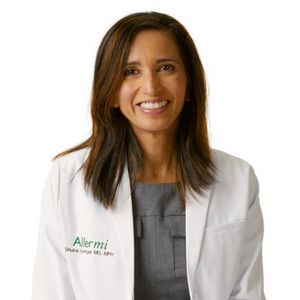Allergies can be a nuisance for many people, causing unpleasant symptoms and affecting their overall quality of life. If you live in New York, you may be familiar with the challenges that come with allergy seasons throughout the year.
Understanding the unique characteristics of each season and the common allergens that trigger symptoms can help you better manage your allergies and stay healthy.
Here's a breakdown of what to expect during each season.
Understanding New York Allergy Seasons
New York experiences distinct allergy seasons throughout the year, each with its own set of allergens and environmental conditions. Understanding the characteristics of these seasons is essential to effectively managing allergies and minimizing symptoms.
Spring
Summer in New York brings its own set of allergens, primarily grass pollen. Grasses like Bermuda grass, Timothy grass, and Kentucky bluegrass are common triggers for allergies during this season.
Additionally, outdoor activities expose individuals to other allergens, such as mold spores, dust mites, and insect bites, which can intensify allergy symptoms.
Summer
Summer in New York brings its own set of allergens, primarily grass pollen. Grasses like Bermuda grass, Timothy grass, and Kentucky bluegrass are common triggers for allergies during this season.
Additionally, outdoor activities expose individuals to other allergens, such as mold spores, dust mites, and insect bites, which can intensify allergy symptoms.
Fall
Fall in New York is notorious for ragweed, one of the most potent allergens. Ragweed pollen can cause severe allergic reactions and is highly prevalent during this season.
Mold spores also remain a common trigger, particularly in damp and humid environments. These allergens can cause nasal congestion, sneezing, and itchy eyes. As temperatures cool, individuals spend more time indoors, where indoor allergens like dust mites and pet dander can exacerbate symptoms.
Winter
Winter in New York may seem like a respite from outdoor allergens, but indoor allergens become more prominent during this season. Spending more time indoors and keeping windows closed can lead to increased exposure to dust mites, pet dander, and mold. Furthermore, dry indoor air can irritate the respiratory system, causing further discomfort for individuals with allergies.
Which Regions in New York Have The Highest Allergen Levels?
Allergen levels can vary across different regions of New York. Remember, individual allergy symptoms can vary based on specific allergen sensitivity and local weather conditions. It's always best to consult with a healthcare provider or allergist for personalized advice. Here are some areas known for their high allergen levels:
Long Island
Long Island experiences high pollen levels, especially during the spring and fall seasons. Tree pollen, such as oak and maple, is particularly abundant in this region.
Hudson Valley
The Hudson Valley region is known for its high mold spore counts. The humid climate and proximity to bodies of water contribute to the growth of mold in this area.
New York City
Urban areas like New York City have higher levels of cockroach allergens due to the dense population and shared living spaces. Dust mites and pet dander are also common allergens in the city.
Western New York
Ragweed pollen is prevalent in the western part of the state, causing seasonal allergies for many residents. This region also experiences high levels of mold spores.
When to Seek Medical Help for Allergies
While many allergies can be effectively managed with self-care measures and over-the-counter medications, there are instances when it is necessary to seek medical help. In this section, we will discuss when it is appropriate to consult a healthcare provider for allergies and the available treatment options.
Treatment Options for Allergies:
There are various treatment options available for allergies, depending on the severity and specific allergens involved. These may include:
- Antihistamines: These medications block the effects of histamine, a chemical released during an allergic reaction, providing relief from symptoms such as sneezing, itching, and runny nose.
- Nasal corticosteroids: These sprays help reduce inflammation in the nasal passages, alleviating congestion, sneezing, and itching.
- Decongestants: Oral decongestants can temporarily relieve nasal congestion, but they should be used for short periods as prolonged use can lead to rebound congestion.
- Eye drops: Eye drops can help relieve itching, redness, and watering of the eyes caused by allergies.
Luckily, there is now another option available that treats all of your allergy symptoms with just one nasal spray. Keep reading to learn more about Allermi!
New York Allergy FAQs
When does allergy season typically occur in New York?
Allergy season in New York usually starts in the spring, around late March or early April, when trees start to release pollen. It continues through the summer months, with grasses and weeds adding to the allergen count. Fall can also bring its own set of allergens, such as ragweed.
How does New York compare to other states?
When it comes to allergies, New York is not alone. Many other states across the United States also have high allergy rates. However, the specific allergens and severity of symptoms may vary. For example, states with a warmer climate may have higher rates of allergies caused by pollen, while states with a humid climate may have more issues with mold and dust mites.
What are the most common allergies in New York?
New York is known for its diverse population and vibrant city life. With such a mix of people and environments, there are several common allergies that affect residents. The most prevalent allergies in New York include:Pollen allergies
- Dust mite allergies
- Mold allergies
- Pet allergies
- Food allergies
CUSTOMIZED ALLERGY TREATMENT AT HOME:
Using multiple over-the-counter allergy treatments is not ideal for getting through allergy season in New York. Most allergists recommend and prescribe nasal sprays. This is because they are considered to be more effective. Nasal sprays go right to the nose to reduce inflammation and prevent it from spreading to the eyes and sinuses. Also, because nasal sprays go directly to the nasal tissue and not the rest of the body, they also usually have far less side-effects than pills.
Skip the drugstore and get a personalized all-in-one allergy treatment from the comfort of your home.
Allermi is a customized nasal spray designed by experienced, board-certified allergists to solve your unique seasonal allergy symptoms. The Allermi formula is backed by science to give you the most effective allergy treatment for your individual allergy symptoms.
The best part? Allermi nasal spray is easy to use and delivered to your door in New York.






